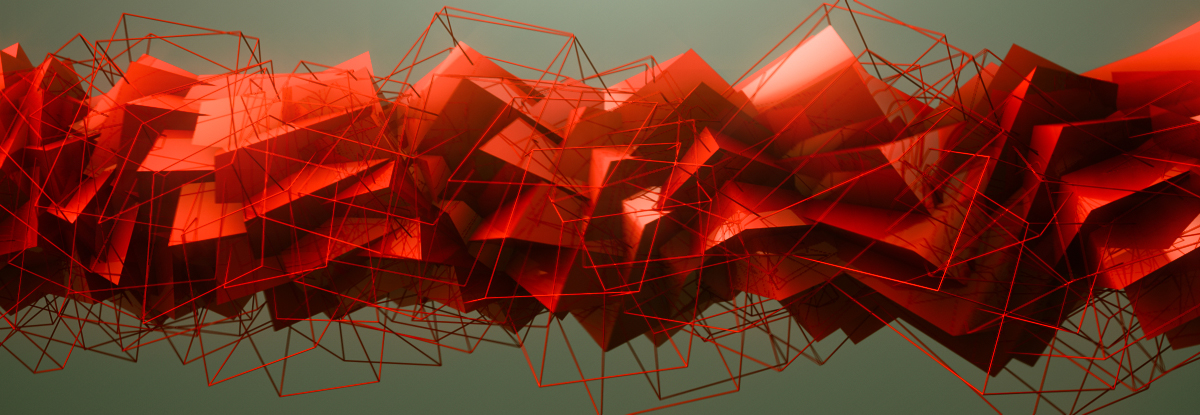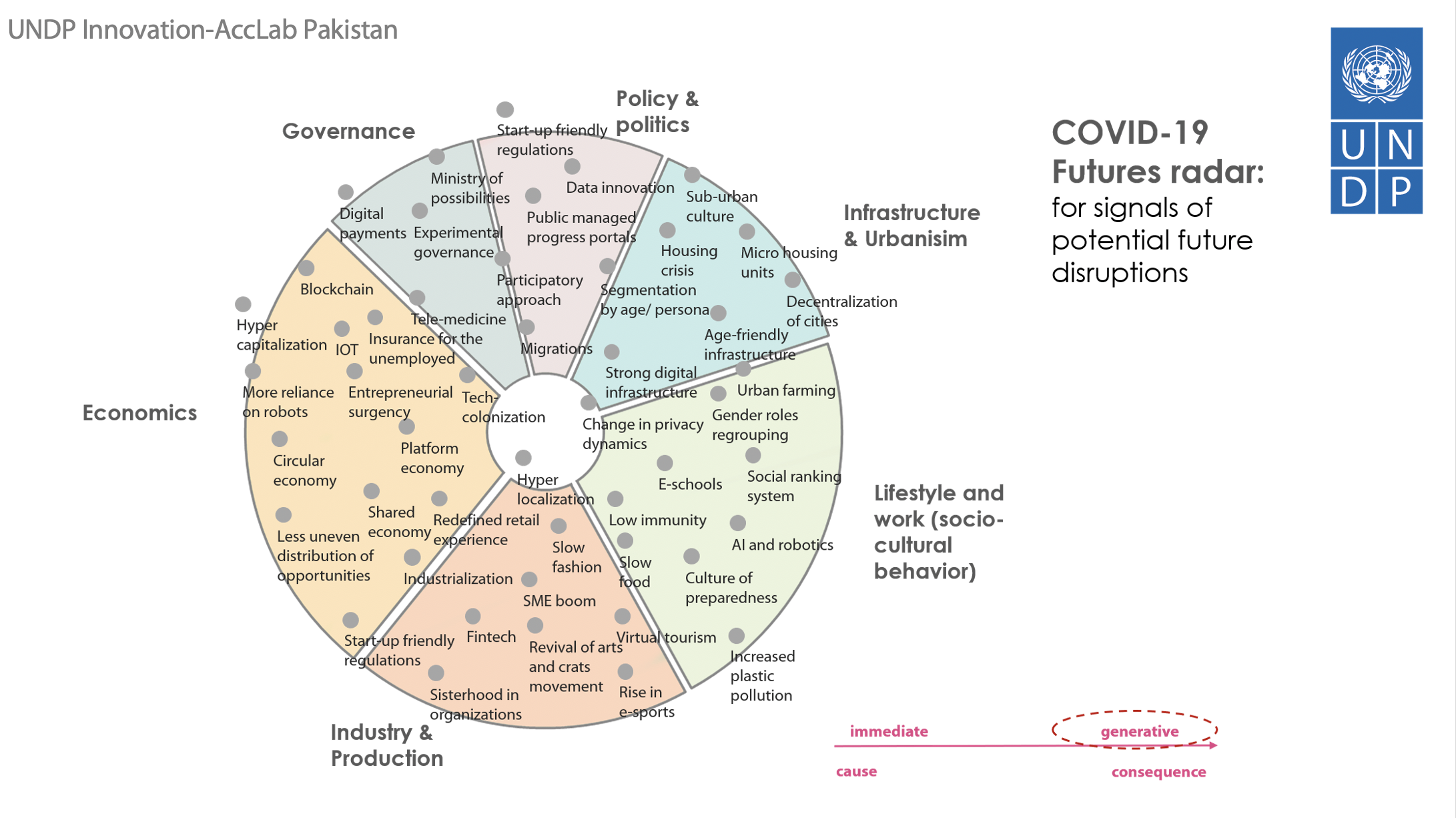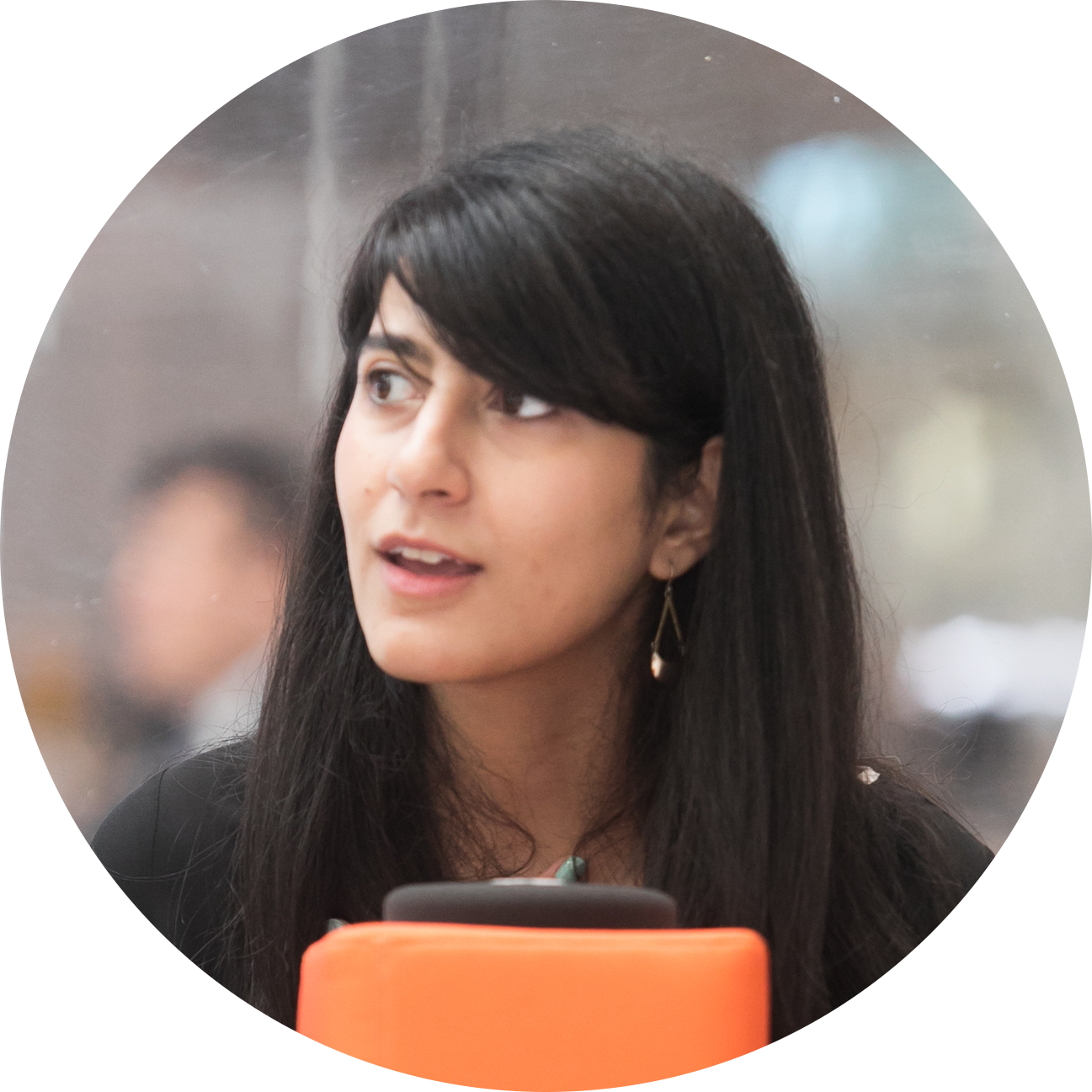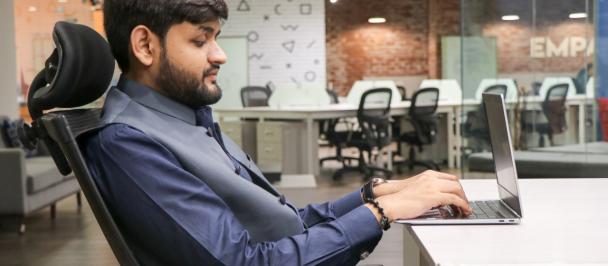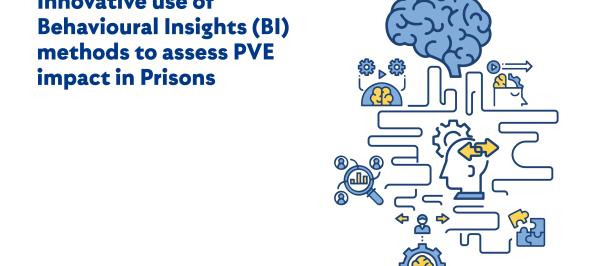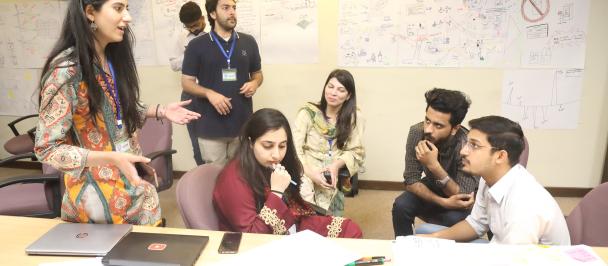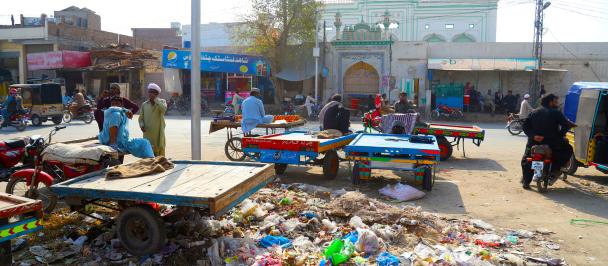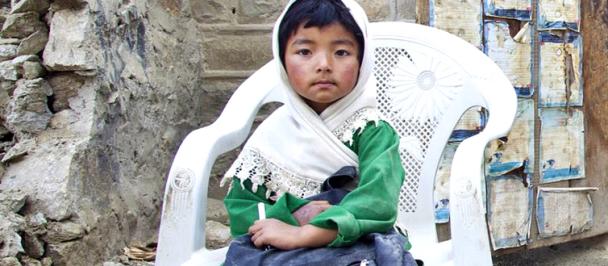Credits: Flux by the courtesy of Plato Art Space
As COVID-19 cases increase and UNDP Pakistan moves into rapid response, the Innovation-AccLab Pakistan team is zooming out from the current crisis management and mapping out emerging disruptive signals of how the new world is beginning to reimagine itself from public policy to urban spaces.
History is full of examples where distress, pandemics, catastrophes and wars have resulted in accelerated cultural and behavioral shifts. COVID-19 is no different. Already we are experiencing new emerging ideas, experiments, products and behaviors. This is a good time to channelize these changes in the right direction and retain the positive shifts.
The world we live in has been shaped by design solutions and is set on the foundation of empathy, sometimes driven by incremental progression and cultural changes and sometimes as a reaction to an event.
Designers can help speculate and guide the way forward into the brave new world(s) as their job description has always been about reimagining products and issues while using a new lens. The pandemic has provided an opportunity for designers to be more relevant than ever before and integrate their approaches in domains they are not commonly associated with, such as policy making and governance.
The Signals of Disruption Radar
It is helpful to think through potential futures like a designer. For that, we first need to get visual. We have built a radar, to see emerging signals of disruption, and which puts together explorations, reflections, and actions visually.
These signals are spread and organized around multiple segments to get a sense of foreseeable futures, some that are happening at this moment and some that are yet to come. These segments include Governance, Policy and Politics, Infrastructure and Urbanism, Lifestyle and Work (behavioral lens), Industry and Production, and Economics.
The radar can be read from inside to outside. The inner space shows the more immediate signals and patterns, while the further you move away from the core, one can see future scenarios and long-term consequences.
The dynamics, interconnectivity, and dependency of these signals across sectors show a glimpse of the new normal. It allows us to examine the post COVID landscape through the lens of a designer curious of people, patterns, and behaviors
Emerging questions of the new futures
The truth is, COVID-19 has forced most of us all to think like designers. We find ourselves asking very meta questions that are all about reimagining the way we intend to experience the world. For instance, what exactly is the new world going to look like? How will it differ from the current state? Will all the changes be catastrophic, or will we be seeing some healthy by-products of the pandemic? How short term or long-lasting will these changes be?
So many questions can be overwhelming. Therefore, the Innovation-AccLab team has clubbed together some questions as we observe emerging initiatives and solutions, changing behaviours, news, social media and conversations. Some of the key questions follow the categories from the Radar above. We think these are relevant for policymakers to explore at this stage as they work on rapid response and long-term planning.
1. More local production
The COVID19 containment strategy through social distancing and partial lockdowns is already resulting in hyperlocalization. We are observing this both at a macro and micro level. It has affected the import, export and financial equations at the national/ international scale, from larger economic index to personal spending. Countries that have industries and self-reliance production internally are not getting as much impacted as Pakistan. Will this hyperlocalization lead to an emergence of local supply chains and production, local industrial wave, and a solid push for small businesses? If yes, then it provides a lot of ‘white space’ to innovation.
2. Self-sustainable
There is already a loud discourse on becoming more self-sustainable such as growing your own food – COVID-19 has accelerated this movement even further. Can we see urban farming, building-as-cities and ‘slobalization’ such as slow food and slow fashion? What is the future of food going to look like? Will retail and industry completely restructure and rebuild itself? Changing consumer needs, new-found appreciation for what is needed rather than wanted, and a definition of lifestyles will allow for a transformation in industries and production. Will we see less of brick and mortar and more of hybrid experiences?
3. The new city
Spanish flu/ Influenza outbreaks in the early 20th century redefined some spatial configuration of our houses through vestibules with the addition of a sink – and the modern-day powder room. How are we re-imagining the form and functionality of our built environment to cater to the post COVID-19 world? Will this give way to micro-housing units, age-friendly development, and the much needed decentralization of cities? Can we imagine going as radical as plug-in cities and portable habitats? Will new urban governance models be embedded in planning? What does the transition from COVID-19/ lockdown to the ‘normal’ look like? Can we apply tactical urbanism as a way to smartly create safe zones within our cities by laying on the existing infrastructure?
4. Schools of the future
Closing of schools for the connected population meant moving classes online. With only 12.4%[1] of population that has used internet and digitals tools in Pakistan, the education gap is causing more disparity between socio-economic segments. In response to this concern, tele-education programs have been launched but the idea is new and the execution urgent, but the gap is still not filled. With the acknowledgment of the need for alternative programs, will the education system be made more adaptive? Can we design a school of the future? What would it look like, and how will it ensure equal distribution of knowledge across the board? Will learner’s characteristics direct curriculums? Will we redefine the engagement models of books and lessons? Is the future of higher education looking like learning-by-doing?
5. Moving to alternative economies
With fuel prices hitting their lowest in a while, most offices and academic centers on a break and with industries in partial dysfunctionality, has deeply affected our economy. There are many liabilities and uncertainties. Immediate solutions are not able to cater to the myriad of surfacing problems.. While we are seeing some organizations and start-ups pivoting their role in response to COVID-19 and its implications, we are also not oblivious to a focus toward (somewhat) equal distribution of aid/ opportunities. Does this mean we are two steps closer to a platform economy and one step closer to the donut economy?
6. Disrupting social and cultural norms
Staying safe will require us to stay distant and move as many interactions as we can online. This may go on for a long time because of the threat of relapses. With Ramazan followed-up by Eid just around the corner, will we see some major changes in our cultural settings? As a society that relies heavily on social ties, will these changes have an impact on our social structures? Will our expectations around relationships change? Will this shrink our social boundaries and make us more comfortable with isolation? Will the concept of privacy and perception change, and trickle down to other streams? Are we seeing social currency models as a new communal acceptance?
7. Mental health as a policy focus
Sudden withdrawal from routines, uncertainty and fear regarding the pandemic, exposure to excessive and non-cohesive information, economic challenges, and social distancing is causing psychological effects. This is reshaping our behavior and the way we perform. Some affects may last forever. Recently, with our support, Sindh Government launched a helpline for psychological counseling for people who have tested positive and are isolated or quarantined and are depressed due to the prevailing circumstances.
8. The future of health
We may see low immunity as a result of frequent hand washing, sanitization and isolation. That may leave us more vulnerable. How will we adapt? Is the current trend of tele-medicine going to meet the demand?
Expanded social welfare: The informal job sector and people dependent on daily wages are becoming more vulnerable. Many are also undocumented. The estimate is that 12.3 million to 18.5 million people in Pakistan will lose their jobs.
Meanwhile, the government’s Ehsaas program has launched has launched a web-portal that will map and provide opportunities to people who have lost jobs in this time. Most recently, the government also shared its Green Stimulus plan in which they are providing an opportunity to people, who have recently lost work to, to plant trees for the Ten Billion trees tsunami programme.
Is this going to push us to create a strong welfare program for future? Perhaps a public-private partnership model?
9. New partnerships
Lack of preparedness of institutes for a pandemic is showing two things. Institutes are asking for help and people and organizations are offering to help. One of the trends that is emerging is a strong blurring of organizations’ boundaries. This is something that won't last for long but will give way to unlikely and non-traditional partnerships. This is a dream for design and innovation champions and their continuous advocacy for inter-disciplinary and inter-sectoral collaboration. Will this make way for the future organization and industrial merger, and on research and development? Can we use this flux to rewrite rules and boundaries? Will our institutions have a stronger culture of preparedness?
Future of work: The lockdown and changes in work modalities has a high acceptance rate. The automation, capacity building, and the balance of the supply and demand cycle in the knowledge-based economy is dictating our work responses. Will the Future of Work take on faster? Has the pandemic busted some myths in this reference? Will this mean more employability of women and differently abled people? Can we accept more remote yet effective businesses?
10. Experimental governance
Urgency requires swift action with little time for planning and processes. Government and governance are relying on experimentation which is not common practice for them. This has positioned the design and innovation community as core team members of these experiments and have accelerated the Next Gen Governance. Can we be optimistic and imagine the marriage of policy and design thinking? Will this integration of new approaches retain their space in the future when the urgency is gone? Is experimental governance the new normal? Will we also have a ministry of possibilities housed in our system? Will the policymaking be more participatory and inclusive?
A pandemic came out of nowhere, halted the entire globe, and highlighted all our weak links. It is requiring a complete systemic restructuring; it would be unwise to completely waste this crisis and not mold it through foresight and empathy.
Follow our space for a follow-up blog with a deeper analysis, on how to retain some of the positive shifts of mental and service models.
[1] According to HIES 2015-16 survey
Edited by:
Ayesha Babar
Communications Analyst/Head, Communications Unit
Author:
Javeria Masood
Javeria Masood is Head of Solutions Mapping at Innovation-AccLab Pakistan. You can follow her on twitter @javeria_mh
Author's note: I would like to thank Beenisch Tahir; Head of Exploration at Innovation-AccLab Pakistan, Ehsan Gul; Head of Experimentation at Innovation-AccLab Pakistan, and Tabindah Anwar; Communications Consultant, for their support and input in writing this piece.
To share your thoughts, please reach out at javeria.masood@undp.org.

 Locations
Locations